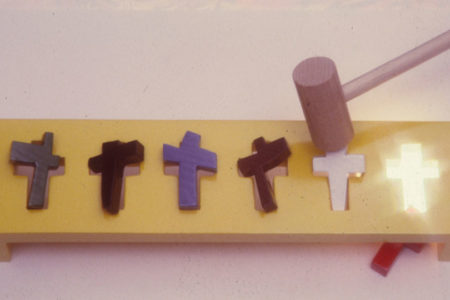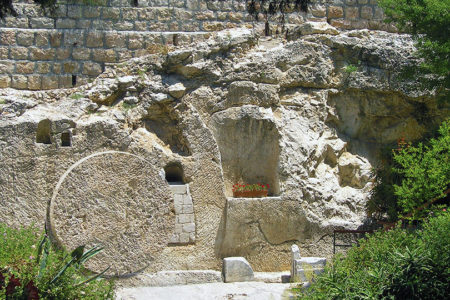The Rapture of the Church
Are You Looking for the Christ or the Antichrist?
A Biblical Analysis of the Time of the Rapture
Introduction
The doctrinal statement of The Friends of Israel Gospel Ministry, Inc. contains the following declarations:
We believe in the premillennial and pretribulational return of Jesus Christ. This means that Christ’s return for His bride (the Church) is imminent and therefore can happen at any moment (1 Th. 4:13–17; 5:6). We believe that, following the Rapture of the Church, the Tribulation Period (Daniel’s 70th Week, or the Time of Jacob’s Trouble) will take place (Dan. 9:24–27; 2 Th. 2:3–4).
These official declarations clearly indicate that The Friends of Israel Gospel Ministry advocates the pretribulation Rapture view. In light of the fact that many fine Christians hold other views concerning the time of the Rapture, why does this Mission believe that Christ will return to rapture the Church out of the world before the 70th Week of Daniel 9 (commonly called the Tribulation period) begins? Several reasons for this belief be presented.
The 70-Week Prophecy of Daniel 9
In Daniel 9:24 Daniel was told that God had determined 70 weeks (70 periods of time, each consisting of seven years) for Daniel’s people (Israel) and his holy city Jerusalem).
It should be noted that all 70 weeks had been determined uniquely for Israel and Jerusalem, not for the Church.
The Church did not exist during any part of the first 69 of the 70 weeks. The 69th week ended with Jesus’ triumphal entry into Jerusalem on Palm Sunday. The Church did not begin until the Day of Pentecost after that Palm Sunday. God consistently kept the Church out of the first 69 weeks. It is evident that He intended the first 69 weeks to be His program for Israel only, not for the Church. This intention is consistent with the fact that God uniquely determined the 70 weeks for Israel only.
God temporarily interrupted His 70-week program for Israel at the end of the 69th week with a gap of time which is now approaching 2,000 years in duration. As a result, the 70th week has not yet begun. This is another way of saying that the Tribulation period has not yet begun. God brought the Church into existence very shortly after He interrupted His 70-week program for Israel, just 57 days after the 69th week ended with the triumphal entry of Christ.
Taken together, the above facts strongly imply three things. First, God does not intend the Church to be present for any of the 70 weeks that He has determined specifically and uniquely for Israel. He intends to keep His 70-week program for Israel and His program for the Church separate and distinct from each other, just as Israel and the Church are distinct.
Second, God does intend the Church to be present specifically and uniquely for the interrupting gap of time between the end of the first 69 weeks and the beginning of the 70th week. If God had intended to mix His 70-week program for Israel with His program for the Church, would He not have started the Church sometime during the first 69 weeks of the 70-week program?
Third, God will remove the Church from the earth before the 70th week begins (before He resumes His 70 week program for Israel).
These implications fit only the pretribulation Rapture view. All other views have the Church going through at least the first half of the 70th week.
The References to the Church and Israel in Revelation
Although the Church is referred to 25 times in the Book of Revelation, none of the references appear in Revelation 4 to 18, the chapters which cover the 70th week of Daniel 9 (the Tribulation period), including the seals, trumpets, and bowls.
By contrast, 26 of the 30 references to Israel in the Book of Revelation appear within chapters 4 to 18. Thus, over 86 percent of the references to Israel occur in the chapters that cover the 70th week of Daniel 9, including the seals, trumpets, and bowls, but none of the references to the Church occur in those chapters.
This contrast is consistent with the implications of the 70-week prophecy of Daniel 9 noted earlier. It is exactly what should be true of the Book of Revelation if the Church is raptured from the earth before the 70th week of Daniel 9 begins (before God resumes His 70-week program for Israel). Thus, this contrast corresponds precisely with the pretribulational Rapture view but conflicts with all other views of the Rapture.
The Beginning of the Day of the Lord’s Wrath
In 1 Thessalonians 1:10 and 5:9 Paul indicated that Church saints will not experience the outpouring of God’s wrath during the future Day of the Lord, implying that the Church will be removed from the earth before that day, with its divine wrath, begins. In light of this implication, the question must be asked, When will the future Day of the Lord, with its outpouring of God’s wrath, begin? Several biblical facts provide the answer to this question.
First, the first four seals of Revelation 6 involve a great outpouring of God’s wrath upon the earth. Three things indicate that this is so: (1) Christ is the One who breaks these seals (vv. 6:1, 3, 5, 7, 9, 12; 8:1); thus, He is the source of the horrors unleashed through the opening of the first four seals. (2) God is the One who determines the extent and effects of the famine of the third seal (v. 6). (3) The first four seals involve death by the sword (war), famine, pestilence (plague) and wild beasts, and the Scriptures indicate that these four things are instruments of God’s wrath (Lev. 26:21–28; Dt. 28:20–26; 32:22–25; Jer. 15:1–9; 16:4, 10–11; 19:7–9, 15; 21:5–7; 44:8, 11–13; Ezek. 5:11–17; 6:3, 1112; 7:3, 8, 14–15; 14:21; 33:27–29; 38:19–22; 39:4)
A comparison of the events following the opening of the first four seals with the beginning of birth pangs (Mt. 24:5–7) indicates that those events and the beginning of birth pangs are the same thing, and there are reasons for concluding that the beginning of birth pangs will take place during the first half of the 70th week of Daniel 9. One of those reasons is that the Bible describes both the time of Jacob’s trouble and the Great Tribulation as unprecedented times of trouble (cp. Jer. 30:6–7 with Dan. 12:1 and Mt. 24:21), thereby indicating that the time of Jacob’s Trouble and the Great Tribulation are the same thing since logically there can be only one such time without precedent. In addition, the Bible associates birth pangs with the time of Jacob’s trouble (Jer 30:6–7). Since the time of Jacob’s trouble and the Great Tribulation are the same thing and since birth pangs are associated with the time of Jacob’s trouble, then birth pangs must also be associated with the Great Tribulation. The Great Tribulation is the unprecedented time of trouble; therefore, the birth pangs associated with it must be the severe birth pangs of hard labor. They cannot be the less severe, beginning birth pangs which precede hard labor. In light of this, the beginning birth pangs of Matthew 24:5–7 must take place during the first half of the 70th week before the Great Tribulation of the second half of the 70th week begins.
The events of the first four seals and the beginning of birth pangs are the same thing and the beginning of birth pangs will take place during the first half of the 70th week; therefore, the first four seals must also take place during the first half of the 70th week.
The first four seals will take place during the first half of the 70th week, those seals will involve a great future outpouring of God’s wrath upon the earth, and the Church will be removed from the earth before that outpouring of God’s wrath upon the earth. It must be concluded, therefore, that the Church will be removed from the earth before the first half of the 70th week.
Second, in 1 Thessalonians 5:2–3 Paul indicated that the coming of the future Day of the Lord will be similar to the coming of a thief in the night and the birth pangs of a woman with child. The similarity that Paul had in mind is that just as a thief in the night and a woman’s birth pangs come suddenly without warning so the future Day of the Lord will come suddenly without warning.
The birth pangs of a woman that come suddenly without warning are her beginning birth pangs, not her later, more severe birth pangs of hard labor. The later birth pangs do not come without warning for they are preceded by the beginning birth pangs. Thus, Paul was teaching that the beginning of the future Day of the Lord will be characterized by the beginning of birth pangs.
As noted earlier, the beginning of birth pangs (Mt. 24:57) will take place during the first half of the 70th week, and the beginning of the future Day of the Lord will be characterized by the beginning of birth pangs. It can be concluded therefore that the future Day of the Lord will include the first half of the 70th week of Daniel 9.
As noted earlier, the Church will be removed from the earth before the future Day of the Lord with his divine wrath begins, and the future Day of the Lord will include the first half of the 70th week; therefore, the Church must be removed from the earth before the first half of the 70th week.
Third, in 1 Thessalonians 5:2–3 Paul indicated that the future Day of the Lord will come suddenly with destruction when the unsaved feel that they have peace and safety in the world. In conjunction with this it is important to note that once the events of the first four seals begin, the world will not be characterized by peace and safety until after the 70th week ends. The rider of the second seal will be given authority to take “the peace” (literal translation) from the earth. The first four seals will bring death to the people of one-fourth of the earth through the sword (war), famine, pestilence, and wild beasts (Rev. 6:8). This is the opposite of peace and safety.
According to the Bible, the sword, famine, pestilence, and wild beasts go together with lack of peace and are the result of God’s withdrawal of peace (Jer. 14:12–14; 16:4–5); but the absence of the sword, famine, pestilence, and wild beasts is characteristic of peace and safety (Lev. 26:56; Ezek. 34:23–30; Hos. 2:18).
The events of the first four seals will be characterized by the opposite of peace and safety, since once they begin the world will not be characterized by peace and safety until after the 70th week ends. Since the future Day of the Lord will come suddenly with destruction when the unsaved feel that they have peace and safety in the world, it can be concluded that the future Day of Lord cannot begin at any time after the events of the first four seals begin. Instead, the future Day of the Lord must include those events.
Since, as noted earlier, the first four seals will be opened during the first half of the 70th week, and the future Day of the Lord will include the opening of the first four seals, it can therefore be concluded that the future Day of the Lord will include the first half of the 70th week.
Because, as noted earlier, the Church will be removed from the earth before the future Day of the Lord with its divine wrath begins, and the future Day of the Lord will include the first half of the 70th Week the Church must be removed from the earth before the first half of the 70th week of Daniel 9.
The Imminency of Christ’s Return
The expression the imminency of Christ’s return means that Christ could return at any moment. Nothing else has to happen before His return.
Two significant things should be noted concerning the imminency of Christ’s return. First, the Bible teaches the imminency of His return in such passages as 1 Corinthians 1:7; 16:22 (“Maranatha” means Oh, Lord come!); Philippians 3:20; 4:5; 1 Thessalonians 1:10; Titus 2:12–13; James 5:7–9; Revelation 16:15; 22:7, 12, 20. Some of these passages declare that the Lord is near or at hand (even at the time the New Testament was written). Others indicate that the believers of the first century were eagerly waiting for Christ to return. All of them imply that He could return at any moment.
Second, throughout the history of the Church many of its leaders have recognized that the Bible teaches the imminency of the Lord’s return. Following are examples of such recognition.
The First Epistle of Clement, 23 (written around 96 AD. by Clement, a prominent leader of the church at Rome who knew some of the apostles personally and probably is the one referred to in Phil. 4:3), “Of a truth, soon and suddenly shall His will be accomplished, as the Scripture also bears witness, saying, ‘speedily will He come, and will not tarry.’”1
The Didache, chapter 16, section 1 (written as early as 70 to 90 A.D. or as late as 120 to 180 AD.), “‘Be vigilant’ over your life; ‘let your lamps’ not be extinguished, or your loins ungirded, but be prepared, for you know not the hour in which our Lord will come.”2
John Calvin, the reformer at Geneva during the 1500s and founder of the Presbyterian Church, made the following statements in some of his commentaries on books of the Bible: “Be prepared to expect Him every day, or rather every moment.” “As He has promised that He will return to us, we ought to hold ourselves prepared, at every moment to receive Him.” “Today we must be alert to grasp the imminent return of Christ.” Commenting on 1 Thessalonians 4, the Rapture passage, Calvin said that Paul “means by this to arouse the Thessalonians to wait for it, nay more, to hold all believers in suspense, that they may not promise themselves some particular time … that believers might be prepared at all times.”3
The Westminster Confession, xxxiii, 3 (written by the Puritans of England during the 1600s), declared that men should “shake off all carnal security and be always watchful, because they know not at what hour the Lord will come.”4
J. Barton Payne, a 20th-century opponent of the pretribulation Rapture view, could not deny that the imminency of Christ’s return was taught in the Bible and was believed by Church leaders throughout the Church age. In his book The Imminent Appearing of Christ, after an entire section dealing with some of the Bible passages upon which the imminency of Christ’s return has been based historically, Payne made the following comment about the concept of Christ’s imminent return: “The preceding section has validated a considerable group of passages that do demonstrate its legitimacy. In fact, no natural reading of Scripture would produce any other conclusion.” Payne also stated, “Belief in the imminency of the return of Jesus was the uniform hope of the early church.” Concerning early Church believers, he said, “They were waiting, eagerly awaiting, His imminent appearing.”5
The pretribulation Rapture view is the only view of the Rapture which comfortably fits the biblical teaching of the imminent return of Christ. It is the only view that can honestly say that Christ could return at any moment and that nothing else has to happen before His return. Since all the other views believe that the Church will go through at least part of the 70th week of Daniel 9 before Christ returns to rapture it, those views cannot honestly say that Christ could return at any moment. According to those views, at least some part of the 70th week of Daniel 9 has to transpire before Christ returns to rapture the Church.
Conclusion
All of the reasons which have been presented correspond only with the pretribulation Rapture view, to which The Friends of Israel Gospel Ministry is therefore committed.
ENDNOTE
1, 2, 3, 4 These items have been quoted from J. Barton Payne, The Imminent Appearing of Christ (Grand Rapids, MI: Wm. B. Eerdmans Publishing Company, 1962), 13, 24-25.
5 Ibid., 102.









A position that is consistent with plain Bible reading as well as faithful exegesis of the Bible as God’s authoritative word.
Beautiful and clear teaching on the Pre-Trib Rapture. Thank you
Thanks for this breakdown of the pre trib rapture. im surrounded by 95% of christians who deny this position. Can you please send me an online version of Behold The Bridegroom Comes teaching the ancient Jewish marriage illustration of the rapture which our Lord taught?
Thanks in advance.
God speed